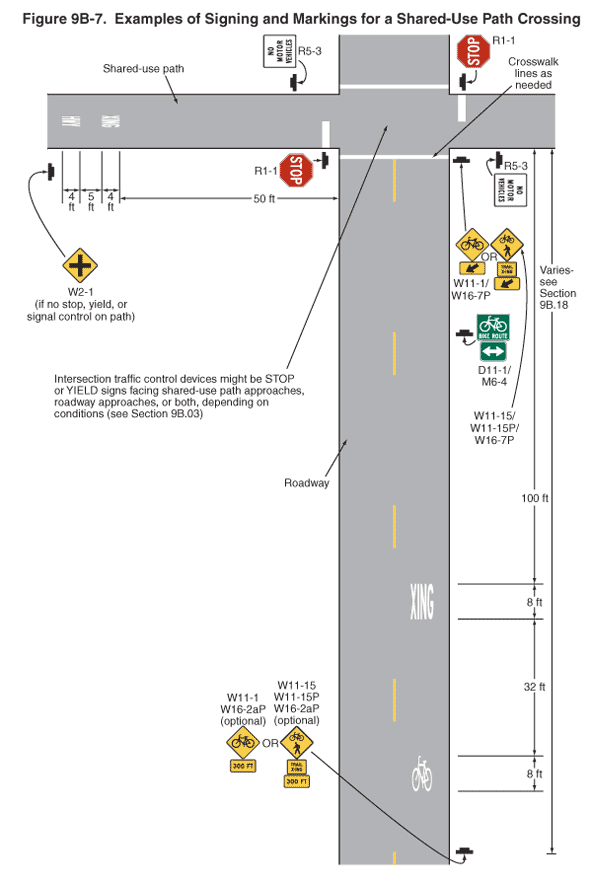|
|
2009 Edition Part 9 Figure 9B-7. Examples of Signing and Markings for a Shared-Use Path Crossing

Figure 9B-7. Examples of Signing and Markings for a Shared-Use Path Crossing
This figure illustrates an example of signing and markings for shared-use paths.
The figure shows an intersection of a vertical roadway and a horizontal shared-use path. The roadway is shown as composed of two lanes separated by a broken yellow line. A note states: "Intersection traffic control devices might be STOP or YIELD signs facing shared-use path approaches, roadway approaches, or both, depending on conditions (see Section 9B.03)."
At the bottom of the vertical roadway, facing northbound traffic, a sign assembly is shown to the right of the roadway. The assembly is shown as composed of a W11-1 bicycle symbol sign mounted above a W16-2aP plaque (marked optional) with the words "300 FT" OR an assembly composed of a W11-15 bicycle and pedestrian symbol sign mounted above a W11-15P plaque with the words "TRAIL X-ING" above a W16-2aP plaque (marked optional) with the words "300 FT." A note states that the distance from this sign assembly to the intersection with the path "Varies—see Section 9B.18." North of this sign assembly, a white symbol of a bicycle is shown marked on the northbound lane in advance of the word "XING" marked in white on the northbound lane. The heights of the bicycle symbol and the word "XING" are both shown as a dimension of 8 ft, and the distance between the symbol and the word is shown as a dimension of 32 ft. The topmost edge of the word "XING" is shown as a dimensioned distance of 100 ft in advance of the intersection with the path. Farther north and in advance of the intersection, a sign assembly is shown to the right of the roadway. It is shown as composed of a D11-1 Bike Route sign mounted above an M6-4 plaque with a two-direction horizontal arrow. Farther north, solid white lines are shown marked on each side of the roadway intersection with the path and parallel to the path. A note with an arrow pointing to one of these white lines states: "Crosswalk lines as needed." Facing northbound traffic on the roadway, a sign assembly is shown to the right of the roadway at the southeast corner of the intersection. The assembly is shown as composed of a W11-1 bicycle symbol sign mounted above a W16-7P plaque with a diagonal arrow pointing down and to the left OR an assembly composed of a W11-15 bicycle and pedestrian symbol sign mounted above a W11-15P plaque with the words "TRAIL X-ING" above a W16-7P plaque with a diagonal arrow pointing down and to the left.
At the westernmost edge of the horizontal shared-use path in advance of the intersection, a W2-1 diamond-shaped yellow sign with a cross is shown to the right of the roadway facing eastbound path traffic and noted as "if no stop, yield, or sign control on path." Just beyond it, the word "HWY" in advance of the word "XING" are shown marked in white centered on the path pavement. Each word is shown as a dimension of 4 ft high with a dimension of 5 ft between the two words. The easternmost edge of the word "XING" is shown as a dimensioned distance of 50 ft in advance of the intersection with the vertical roadway. An R1-1 Stop sign is shown facing eastbound path traffic at the intersection with the roadway. Adjacent to the R1-1 Stop sign, a white stop line is shown extending across the right half of the shared-use path. Opposite the Stop sign and on the other side of the path facing westbound path traffic, an R5-3 sign is shown with the words "NO MOTOR VEHICLES" on three lines.
On the east part of the horizontal path in advance of the intersection, an R1-1 Stop sign is shown to the right side of the path, facing westbound path traffic. Adjacent to the Stop sign, a white stop line is shown extending across the right half of the path. On the other side of the path, just east of the intersection and facing eastbound path traffic, another R5-3 sign is shown with the words "NO MOTOR VEHICLES" on three lines.
